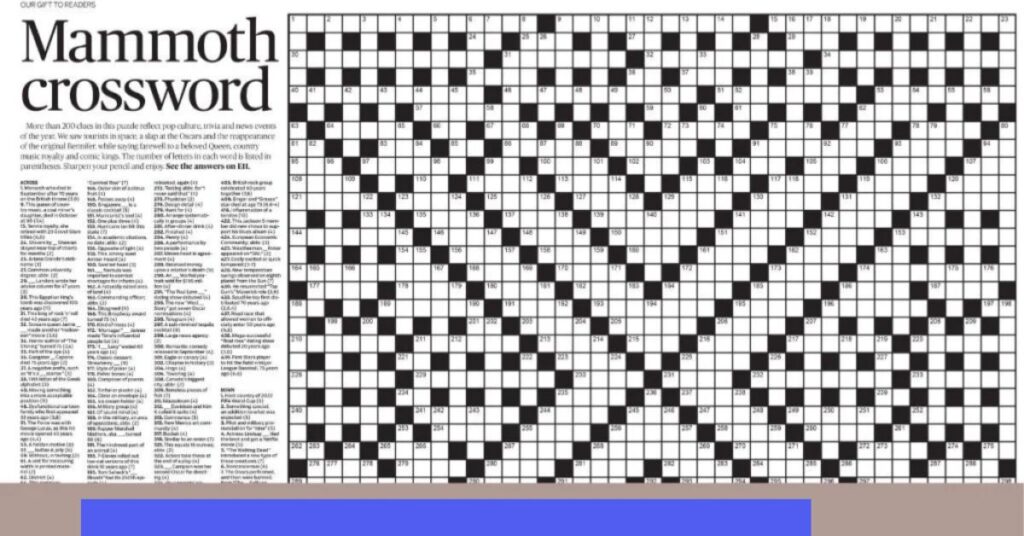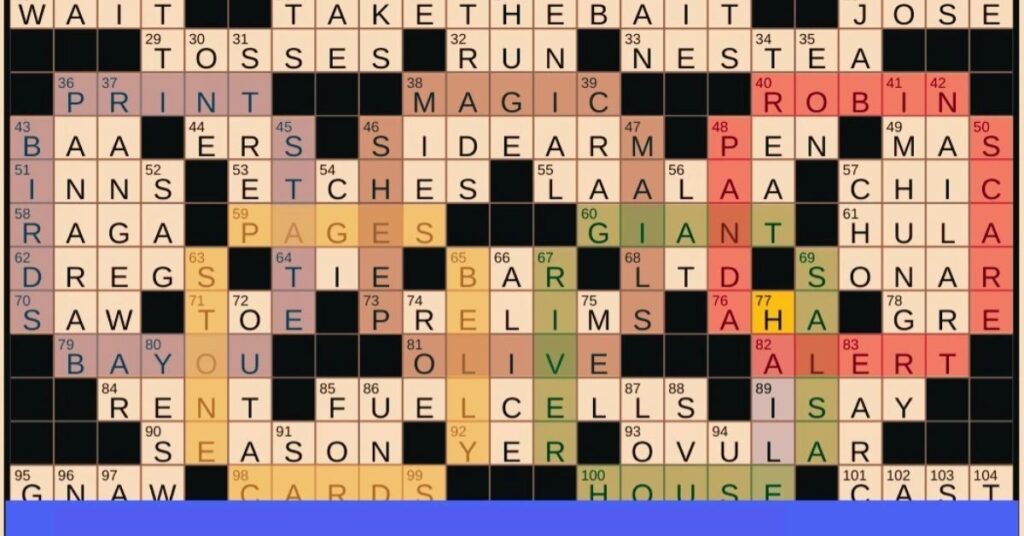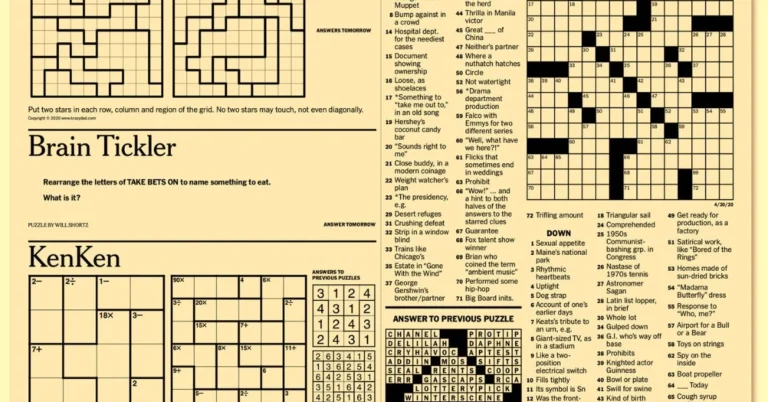The New York Times (NYT) Crossword is a beloved pastime for many puzzle enthusiasts. With its intricate wordplay, clever clues, and engaging themes, it offers a mental workout that’s both entertaining and challenging. One clue that has gained attention over time is “Second Place”. Deciphering its meaning in the context of a crossword can be both puzzling and enlightening. In this article, we will explore how to interpret such clues, dive into the nuances of crossword construction, and understand why the “second place NYT Crossword” continues to fascinate solvers.
The Allure of NYT Crossword Clues
The NYT Crossword is renowned for its blend of simplicity and complexity. A single word or phrase can have multiple interpretations, depending on its placement in the puzzle and its interplay with other clues.
For instance, when faced with the clue “Second Place”, solvers might initially think of common answers like runner-up or silver medal. However, in true NYT fashion, the answer might involve lateral thinking, such as a wordplay hint at a location or a sequential position within a word.
Understanding such clues requires a blend of vocabulary, cultural knowledge, and a willingness to think beyond the obvious. This is what makes solving a second place NYT Crossword so rewarding—it challenges your brain to work in unconventional ways.
What Does “Second Place” Really Mean?

In the context of the second place NYT Crossword, the clue often goes beyond the literal meaning of coming second. Here are some interpretations that solvers might encounter:
- Sequential Thinking:
The clue might refer to the second letter in a word or the second position in a sequence. For example, if the clue is “Second place in ‘dance’,” the answer might be “a” (the second letter). - Metaphorical Placement:
The answer could relate to a concept of being secondary, such as “backup” or “plan B.” - Physical Locations:
A “second place” might be interpreted as a geographical or spatial reference, such as a second city or a duplicate location.
These layers of interpretation make the second place NYT Crossword not only a test of knowledge but also of creativity and adaptability.
The Construction of Crossword Puzzles
Behind every engaging puzzle is a meticulous construction process. Puzzle creators, known as cruciverbalists, craft clues and answers that align with a specific theme or difficulty level. For example, in a second place NYT Crossword, the constructor might embed the idea of “second” throughout the grid:
- Words with hidden second meanings.
- Clues that involve sequences, like days of the week (Tuesday being the second).
- Themes around second chances or silver-tier achievements.
The result is a puzzle that feels cohesive and rewarding, even as it stretches your mental muscles.
Why We Love Wordplay in Crosswords
The popularity of the second place NYT Crossword reflects a broader appreciation for wordplay among solvers. Wordplay offers a sense of discovery—solving a tricky clue feels like unlocking a small mystery.
For example, consider this hypothetical clue: “Second place to eat in France.” While the surface interpretation might suggest a restaurant, the answer could be B (the second letter of “Bistro”). This layered approach to clueing keeps solvers engaged and fosters a sense of accomplishment when the “aha!” moment arrives.
Tips for Tackling the “Second Place” Clue
If you’re stumped by the second place NYT Crossword clue, here are some strategies to help:
- Look for Patterns:
Examine the number of letters in the answer and consider its position in the grid. This can offer hints about whether the clue refers to a specific letter, a concept, or a location. - Think Laterally:
Don’t fixate on the literal meaning of “second place.” Instead, consider synonyms, homophones, or idiomatic expressions. - Leverage Cross-Clues:
Use intersecting answers to narrow down possibilities. If the second letter of the answer is already filled, it can guide your thinking. - Embrace the Theme:
In themed puzzles, the title or a central clue often provides a hint. A second place NYT Crossword might have recurring motifs around “second.” - Consult Resources:
It’s okay to use a dictionary or a crossword-solving app to learn and grow. With practice, you’ll start to recognize patterns and common tricks used in the NYT Crossword.
How “Second Place” Reflects Broader Themes
Crosswords often serve as a mirror to culture, language, and even philosophy. The idea of second place NYT Crossword can evoke themes of perseverance, humility, and the value of being a runner-up.
Historically, crossword puzzles have celebrated the idea that the journey is as important as the destination. Similarly, a “second place” might remind solvers that success isn’t always about coming first—it’s about engaging with the challenge and enjoying the process.
Famous “Second Place” Moments in Crossword History

Over the years, the NYT Crossword has featured many memorable moments tied to the concept of second place. Whether it’s clues that pay homage to Olympic silver medalists or puzzles centered on second cities like Chicago, these instances showcase the puzzle’s ability to blend trivia with thematic depth.
One noteworthy second place NYT Crossword featured a theme around backup plans, with answers like “contingency” and “alternate.” Another highlighted famous sequels in literature and film, turning “second” into a celebration of continuity and creativity.
Why You Should Embrace the Challenge
For both novice and experienced solvers, the second place NYT Crossword offers an opportunity to stretch your thinking and expand your linguistic skills. Each puzzle is a chance to learn something new, whether it’s a word you’ve never encountered or a clever way of interpreting a familiar phrase.
Moreover, solving crosswords can be a deeply meditative and satisfying activity. It allows you to unplug from daily distractions and immerse yourself in a world of words and patterns.
Conclusion
The second place NYT Crossword is more than just a puzzle—it’s a mental adventure that challenges and delights in equal measure. Its clues, layered with meaning and creativity, exemplify why the NYT Crossword remains a cultural institution.
So, the next time you encounter the clue “Second Place”, take a moment to think outside the box. Whether the answer is straightforward or a cleverly disguised twist, solving it will undoubtedly bring a sense of achievement. After all, in the world of crosswords, every solver is a winner.
Read more: Black Tie Affairs NYT Crossword An Insight into the Game



